Luxury Vinyl Tile vs. Hardwood Flooring
LVT vs. Hardwood Flooring
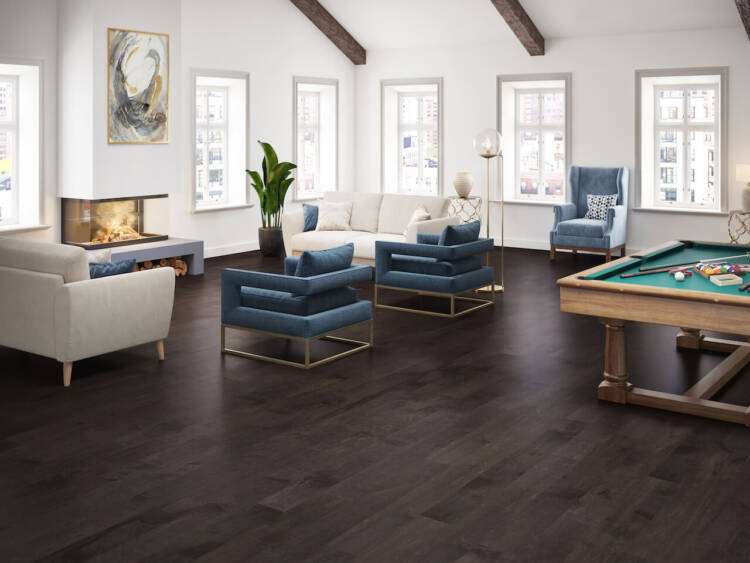
It’s an age-old debate: Should I use hardwood or LVT flooring? They have many similarities, in terms of durability, design options and elegance. These two flooring materials are also quite different; one is made from a natural resource while the other is manufactured from raw materials. With this many varying factors, it can be hard to choose between hardwood and LVT. But what if you didn’t have to choose?
It turns out, hardwood flooring and LVT work quite well in together in a number of commercial settings — you just have to understand their strengths and weaknesses.
To best illustrate the comparable characteristics of LVT vs. hardwood flooring, let’s break flooring down into five quantifiable qualities:
- Look & Style
- Durability & Stability
- Environmental Impact
- Applications
- Cost
Look & Style
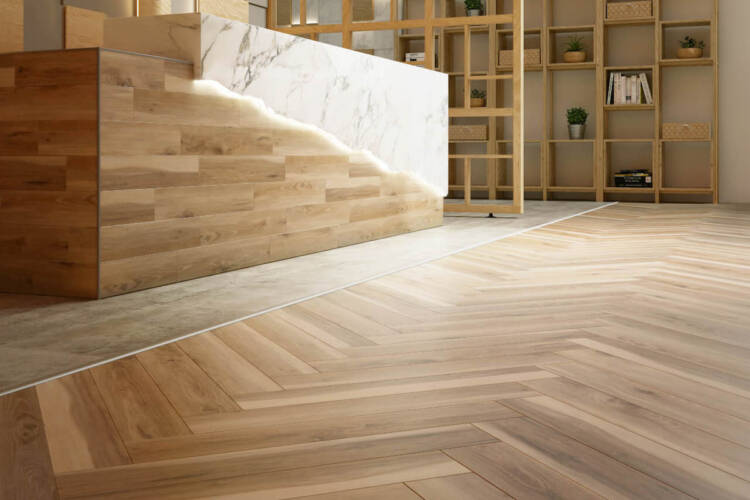
Hardwood flooring is timeless and has long been a staple in interior design. However, the advancements in LVT technology have helped it gain widespread notoriety for its beauty and durability. When it comes time to choose between hardwood and LVT, it really comes down to the look and style you’re trying to achieve for a particular area.
With both hardwood and LVT, you will have numerous design options at your disposal. But there are some differences that may influence design decisions. First, hardwood planks are typically longer (up to 7 feet long) than LVT planks (up to 4 feet long on average). And with real hardwood you are getting a natural material, so it will have unique elements such as knots and grain patterns. With LVT, each design has been digitally perfected so you can achieve the exact look that you’re going for in an easily repeatable pattern.
Also, some specialty wood species, while beautiful, aren’t durable enough to hold up in a commercial environment. For example, bamboo flooring is popular in spas and other commercial spaces with a Scandinavian design. But natural bamboo flooring is quite soft — this would be a great opportunity to use real wood in the entry area while continuing the design with LVT that looks like bamboo.
This is made possible because the look and style of LVT is derived from a real photographic image layer between the backing and the clear wear layer. With constant and exponential developments in digital photography and image editing/manipulation, LVT designers need only photograph the desired subject to create a nature-realistic product.
Hardwood Flooring
- Hardwood flooring is timelessly beautiful.
- Comes in many colors, qualities and styles.
- Available in longer plank lengths.
LVT
- Available in many different colors, styles, and designs.
- Can continue a wood-look in an area with moisture.
Durability & Stability
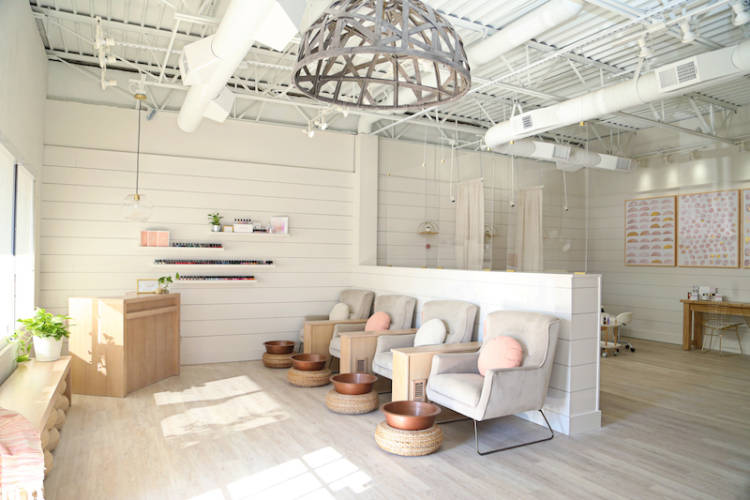
Before discussing the durability and stability of LVT vs. hardwood, we should define these terms, as they seem similar.
- Durability: Hardness of the flooring — especially its topmost wear layer. The more durable a flooring, the more use it can take.
- Stability: Governed by the thickness of the whole and/or makeup of layers and quality of materials. Stable flooring material holds its shape and size against moisture and/or climate changes.
The good news is that hardwood flooring and LVT are equally durable materials. While LVT is manufactured that way, wood is a naturally occurring material which means it has to undergo strict testing to be deemed suitable for commercial spaces.
Wood is naturally hard, so hardwood flooring is very durable and stable. This durability is improved by a factory-applied coating that protects the hardwood and keeps it looking good as new. It is important to note that engineered hardwood flooring shouldn’t have any additional coatings or waxes applied to it, as that can compromise the protective coat.
While hardwood flooring will hold up in multiple commercial environments, it is best to avoid using it in areas where it could get a lot of moisture exposure. Bathrooms, laundry areas or sometimes kitchens get a lot of water on the floors, which could wear down the hardwood over time.
As a synthetic material, LVT is resistant to moisture and climate. Parterre’s LVT, for example, is made with high quality vinyl — manufactured with multi-directional base layers under a flat, hot press method. This gives the flooring a memory for straightness that holds up under reasonable moisture and temperature changes. Created under great heat and pressure, the many layers of LVT ensure it will hold up under heavy use.
LVT is extremely durable and stable, and its hard wear layer makes it long-lasting and applicable to nearly any situation. Most warranties grant use under commercial conditions.
Hardwood Flooring
- Hardwood flooring is both durable and stable.
- Factory-applied coating protects and shines.
- Suitable for many commercial areas.
LVT
- Extremely durable and stable.
- Little to no upkeep.
- A hard wear layer makes LVT long-lasting and applicable to nearly any situation.
Environmental Impact
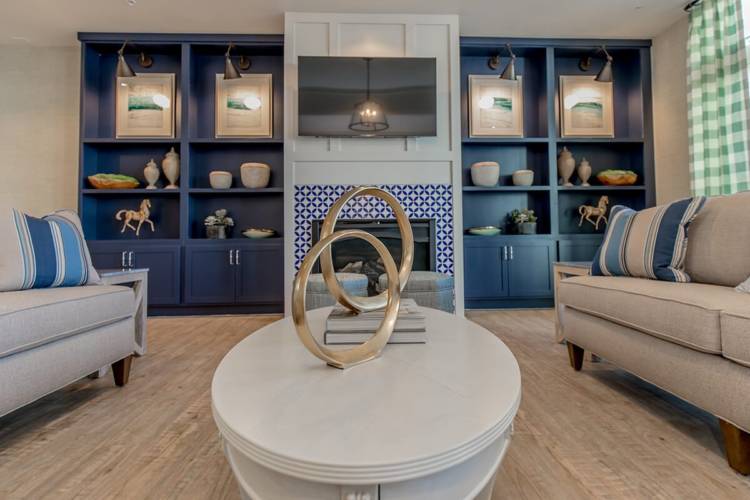
Hardwood flooring is obviously a natural resource, and on the surface that may sound harmful, there are many flooring manufacturers who are working to fight deforestation. It is quite common for hardwood to be harvested from company-run tree farms, where harvesting is done on a cycle with new trees planted to consistently replenish the resource. And engineered hardwood employs a manufacturing process that ensures nearly all parts of the tree are used — the plywood layer under the top plank is made up of recycled wood scraps and leftover materials.
LVT flooring also inspires some negative connotations, as many people think that manufacturing processes that utilize vinyl are bad for the environment. At Parterre, we are proud of our sustainability efforts and have a specialized manufacturing process that keeps the environment top of mind. Our LVT flooring is comprised of recycled materials, is recyclable and is made from a synthetic (PVC) whose main component is an extremely abundant resource — salt.
Hardwood Flooring
- Harvested from a sustainable natural resource.
LVT
- Parterre’s version is recyclable and comprised of recycled materials.
Applications
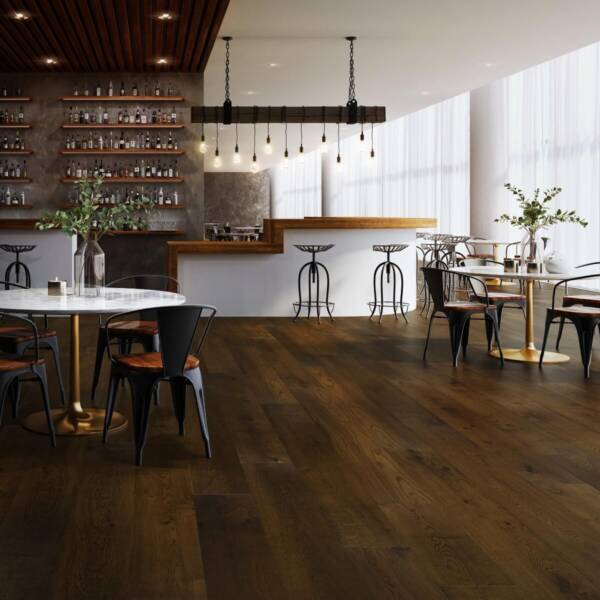
Hardwood flooring and LVT can and should be used in nearly all of the same commercial environments. Hospitality, multi-family, retail, corporate and more are all suitable settings for both hardwood and LVT — there are, however, a few exceptions.
Hardwood is an elegant and timeless choice for nearly any flooring application except areas with excessive moisture. This means hardwood shouldn’t be used in areas like bathrooms, or restaurant kitchens. These areas are great options for an LVT floor.
LVT’s naturally moisture-resistant properties makes it perfect for a supermarket’s produce areas or kitchens and bathrooms. The stability and durability with which it is manufactured equips it for commercial use in retail, hospitality, healthcare, educational, residential and fitness settings.
Hardwood Flooring
- Suitable for nearly any commercial environment
- Should not be used in areas with lots of moisture
LVT
- Moisture resistant
- Stability and durability suitable for commercial use
Cost
When you use hardwood or LVT, you’re doing so because you want a luxurious focal point for your design. With high-end finishes come slightly higher price tags, but both hardwood and LVT are long-term investments that will provide longevity and elegance to any space.
When it comes down to dollars and cents, hardwood flooring is a bit more expensive than LVT. This is due to the fact that is a natural resource that must be harvested, milled and finished, while LVT can be repeatedly manufactured in one location. As far as maintenance is concerned, both flooring materials can be easily maintained with simple floor cleaners and the mop and bucket system.
Hardwood Flooring
- Regular maintenance and treatment costs.
Luxury Vinyl Tile
- Minimal maintenance costs.
Luxury Vinyl Tile (LVT) vs. Hardwood: An Overview
Look & Style
Cost
Durability & Stability
Applications
If you found this comparison of LVT vs. hardwood flooring helpful, you can find more information on our blog. We at Parterre are not only the leaders in modern, high-quality LVT and hardwood, we’re artists dedicated to creating stunning commercial floors. Let us help you fully realize your next project with the perfect flooring choice.
SaveSave
SaveSave
SaveSave
SaveSave
Roche FitzGerald
Roche FitzGerald, Lead Product Designer for Parterre, is a second-generation artisitc giant in the flooring industry developing an appreciation for art and physical composition from his father, who was also an artist and leader in surface design.
“The mindset I have when creating art is that accidents are beautiful, which is something my father instilled in me,” said Roche. “There is an allure to discovering organic textures, patterns, and colors.”
A true artist at heart, Roche shapes designs from his own paintings or the inspirations of daily life. In the early 2000s, while other companies were turning to their manufacturers for options, Roche led the way in producing original flooring designs earning multiple industry awards and recognition for his luxury vinyl designs.
Polished Concrete vs. Vinyl Flooring
Polished Concrete vs. Vinyl Flooring Polished concrete vs. vinyl flooring. It’s not an easy decision, considering both provide an excellent solution for commercial flooring. The look of concrete floors has been a growing trend for commercial interiors.
Chevron and Herringbone
Break the Pattern of Commercial Flooring You can add more flair to your commercial flooring by breaking from the look of traditional straight-line, square, and diagonal patterns. Eye-catching looks like chevron and herringbone will dot the designer landscape in 2024.